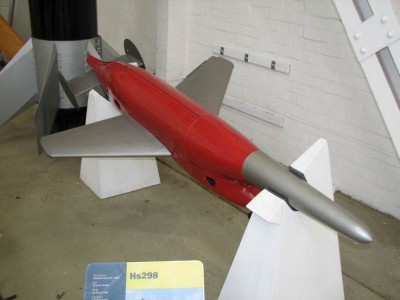Development at Henschel began in early 1944. The rocket conceptually matched the company's previous designs, having arrow wings and a tailplane with a double rudder. It was controlled by radio commands from the parent aircraft (an improved Kehl - Strassburg system) based on its visual tracking and target tracking by the three-point method. The command transmitter was capable of providing communications up to a range of 1.5 km. Trial firing took place in December 1944, with the missiles carried by a Ju 88G. On the first attempt the missile exploded, on the next it crashed into the ground. According to the results of further tests, the accuracy of the hits was reportedly only 20%.
All in all, by 6.2.1945, when the project was cancelled, about 300 Hs 298V-1 (March-September 1944) and about 100 Hs 298V-2 (until February 1945)
TTD:
Weight: 120 kg
Engine: Schmidding 109-543 solid fuel, starting thrust 1.5 kN for 5 s, flight thrust 0.5 kN for 20 s
Warhead: 25-48 kg explosive with Fox or Kranich contact igniter
Source. Kroulík, B. Ružička: Vojenské rakety, Naše vojsko, Praha, 1985, 592 p., ISBN 28-067-85
One surviving specimen is from the Royal Air Force Museum in Cosford.
All in all, by 6.2.1945, when the project was cancelled, about 300 Hs 298V-1 (March-September 1944) and about 100 Hs 298V-2 (until February 1945)
TTD:
Weight: 120 kg
Engine: Schmidding 109-543 solid fuel, starting thrust 1.5 kN for 5 s, flight thrust 0.5 kN for 20 s
Warhead: 25-48 kg explosive with Fox or Kranich contact igniter
Source. Kroulík, B. Ružička: Vojenské rakety, Naše vojsko, Praha, 1985, 592 p., ISBN 28-067-85
One surviving specimen is from the Royal Air Force Museum in Cosford.
